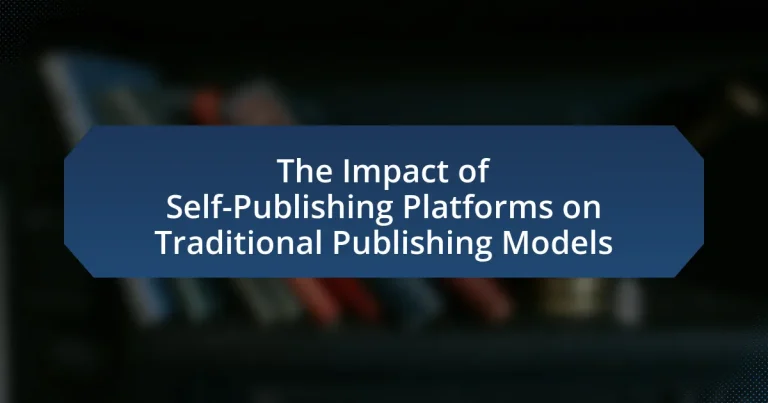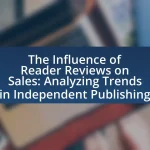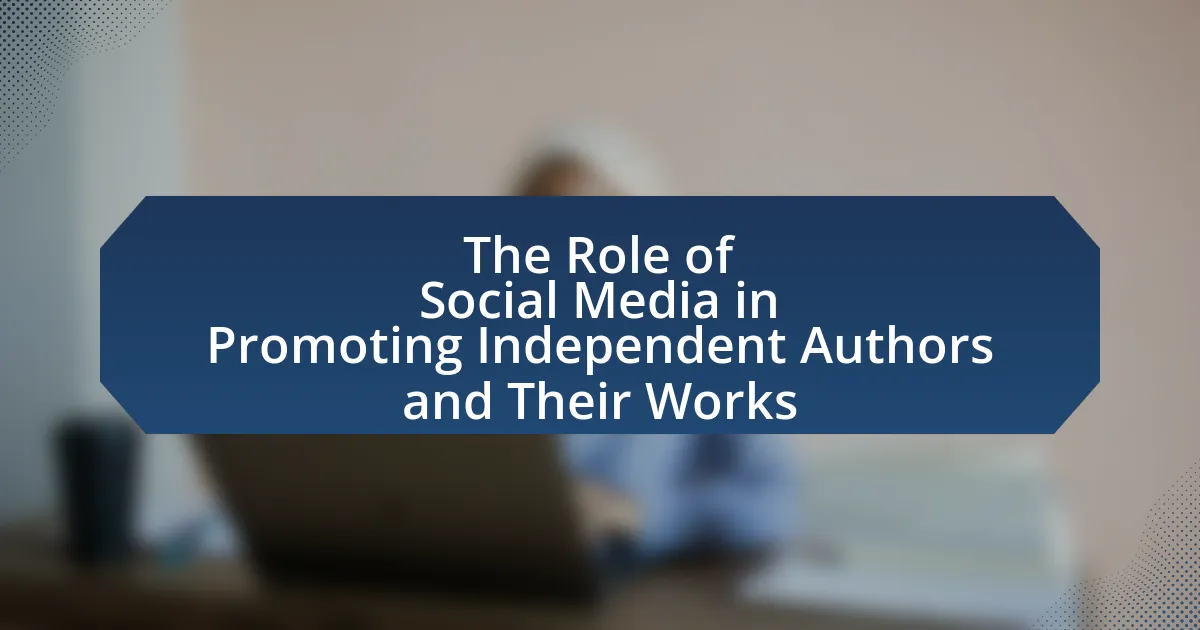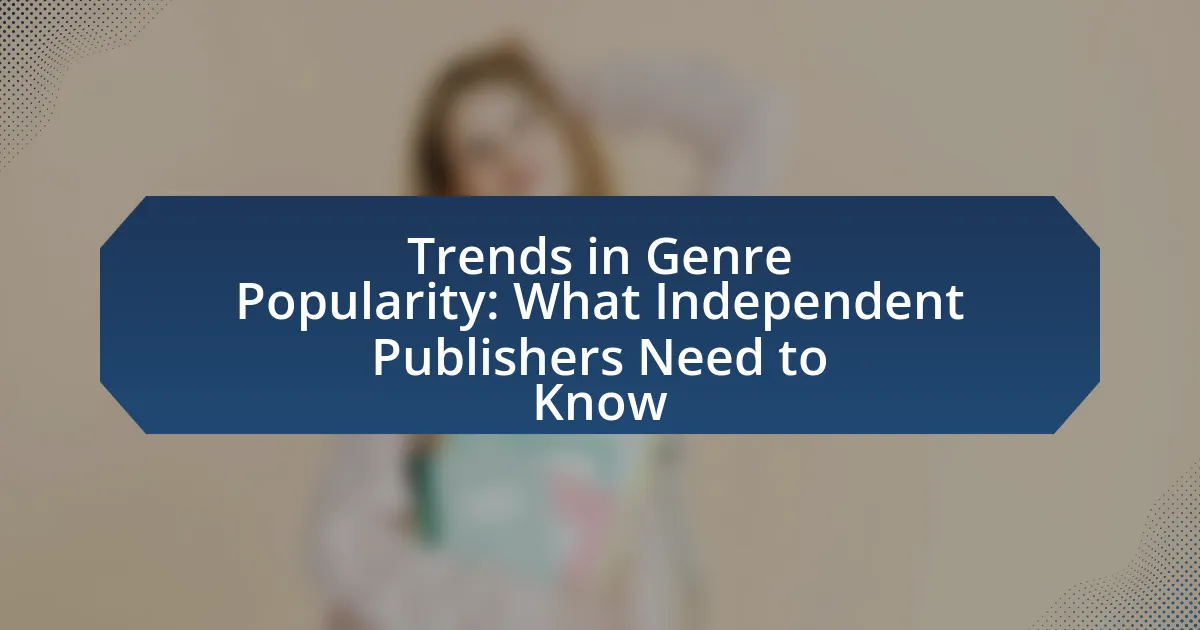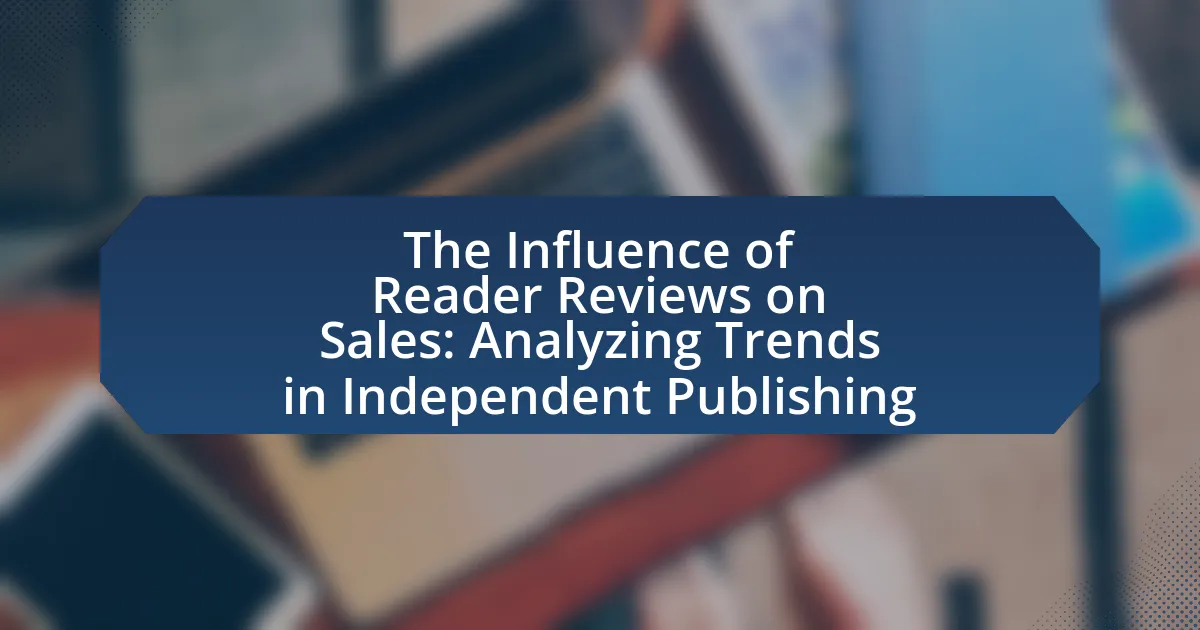Self-publishing platforms, such as Amazon Kindle Direct Publishing and Smashwords, have transformed the publishing industry by enabling authors to publish independently, retain creative control, and achieve higher royalty rates. These platforms democratize access to publishing, allowing diverse voices and niche genres to flourish, while also presenting challenges such as marketing difficulties and quality control issues. The rise of self-publishing has significantly impacted traditional publishing models, prompting adaptations in author-publisher relationships and revenue streams. As self-published titles account for a growing share of the market, the industry is witnessing a shift towards hybrid publishing models and increased reliance on digital strategies, influenced by advancements in technology and changing consumer preferences.

What are Self-Publishing Platforms and Their Role in the Publishing Industry?
Self-publishing platforms are online services that allow authors to publish their works independently, bypassing traditional publishing houses. These platforms, such as Amazon Kindle Direct Publishing and Smashwords, enable authors to retain creative control, set their own prices, and receive higher royalty rates compared to traditional publishing, which typically offers lower percentages and more restrictions. The role of self-publishing platforms in the publishing industry is significant; they democratize access to publishing, allowing a diverse range of voices to be heard and providing opportunities for niche genres that may not attract traditional publishers. According to a 2021 report by the Alliance of Independent Authors, self-published authors generated over $1 billion in revenue, illustrating the growing impact of these platforms on the overall publishing landscape.
How do self-publishing platforms operate?
Self-publishing platforms operate by allowing authors to publish their works independently without the need for traditional publishing houses. These platforms provide tools for formatting, distribution, and marketing, enabling authors to upload their manuscripts, select pricing, and choose distribution channels. For instance, platforms like Amazon Kindle Direct Publishing and IngramSpark facilitate access to global markets, allowing authors to reach readers directly. According to a 2021 report by the Author Earnings Project, self-published authors earned approximately $1.2 billion in revenue, highlighting the significant financial opportunities available through these platforms.
What are the key features of popular self-publishing platforms?
Key features of popular self-publishing platforms include user-friendly interfaces, extensive distribution networks, and customizable formatting options. User-friendly interfaces allow authors to easily navigate the publishing process, while extensive distribution networks enable books to reach multiple retailers and libraries globally. Customizable formatting options give authors control over the design and layout of their work, enhancing the overall presentation. Additionally, many platforms offer marketing tools and analytics to help authors promote their books effectively and track sales performance. These features collectively empower authors to publish and market their work independently, significantly impacting traditional publishing models.
How do authors utilize these platforms to publish their work?
Authors utilize self-publishing platforms to directly publish their work without the need for traditional publishing houses. These platforms, such as Amazon Kindle Direct Publishing and Smashwords, allow authors to upload their manuscripts, set pricing, and manage distribution to a global audience. This method provides authors with greater control over their content, faster publication timelines, and higher royalty rates, often exceeding 70% compared to the 10-15% typical in traditional publishing. The rise of these platforms has significantly disrupted traditional publishing models by enabling authors to reach readers directly, thus bypassing gatekeepers and allowing for a diverse range of voices and genres to emerge in the literary market.
What advantages do self-publishing platforms offer to authors?
Self-publishing platforms offer authors greater control over their work, allowing them to retain rights, set pricing, and choose marketing strategies. This autonomy enables authors to make decisions that align with their vision and goals, unlike traditional publishing, where these aspects are often dictated by publishers. Additionally, self-publishing platforms typically provide faster publication timelines, allowing authors to bring their work to market more quickly. According to a 2021 survey by the Alliance of Independent Authors, 70% of self-published authors reported higher earnings compared to their traditionally published counterparts, highlighting the financial benefits of self-publishing.
How do self-publishing platforms enhance creative control for authors?
Self-publishing platforms enhance creative control for authors by allowing them to retain ownership of their work and make independent decisions regarding content, design, and marketing. Unlike traditional publishing, where authors often relinquish rights and face editorial constraints, self-publishing enables authors to choose their own cover art, formatting, and promotional strategies. For instance, platforms like Amazon Kindle Direct Publishing and IngramSpark provide tools that empower authors to publish their books on their terms, ensuring that their vision is fully realized. This autonomy is supported by the fact that self-published authors can directly engage with their audience, gather feedback, and make adjustments without the delays typically associated with traditional publishing processes.
What financial benefits do authors gain from self-publishing?
Authors gain significant financial benefits from self-publishing, primarily through higher royalty rates and direct control over pricing. Unlike traditional publishing, where authors typically receive 10-15% royalties on sales, self-published authors can earn 60-70% royalties on their book sales, depending on the platform used. For instance, Amazon’s Kindle Direct Publishing offers authors up to 70% royalties on eBooks priced between $2.99 and $9.99. Additionally, self-publishing allows authors to set their own prices, enabling them to respond to market demand and maximize profits. This financial autonomy can lead to greater overall earnings, especially for successful titles, as authors retain all rights to their work and can explore multiple revenue streams, such as audiobooks and merchandise.
What challenges do authors face when using self-publishing platforms?
Authors face several challenges when using self-publishing platforms, including limited visibility, marketing difficulties, and quality control issues. Limited visibility arises because self-published works often compete with established authors and traditional publishers, making it hard for new authors to gain traction. Marketing difficulties stem from the need for authors to independently promote their work, which can be overwhelming without prior experience or resources. Quality control issues occur as self-published authors may lack access to professional editing and design services, potentially leading to subpar final products. These challenges highlight the complexities authors encounter in navigating the self-publishing landscape.
How do marketing and visibility issues affect self-published authors?
Marketing and visibility issues significantly hinder self-published authors by limiting their reach and sales potential. Without effective marketing strategies, self-published authors struggle to attract readers, resulting in lower book sales and diminished recognition in a saturated market. According to a 2021 survey by the Alliance of Independent Authors, 70% of self-published authors reported that marketing was their biggest challenge, highlighting the critical role of visibility in their success. Furthermore, self-published authors often lack the resources and networks that traditional publishers provide, making it difficult to gain traction and compete effectively.
What are the common pitfalls in the self-publishing process?
Common pitfalls in the self-publishing process include inadequate editing, poor cover design, and ineffective marketing strategies. Inadequate editing often leads to a subpar reading experience, as self-published authors may overlook the importance of professional proofreading and content editing, which can result in grammatical errors and structural issues. Poor cover design can negatively impact a book’s marketability; research shows that 75% of readers judge a book by its cover, making it crucial for self-published authors to invest in quality design. Ineffective marketing strategies can hinder visibility; without a solid marketing plan, even the best-written books may fail to reach their target audience, as self-published authors often lack the resources and knowledge to effectively promote their work.
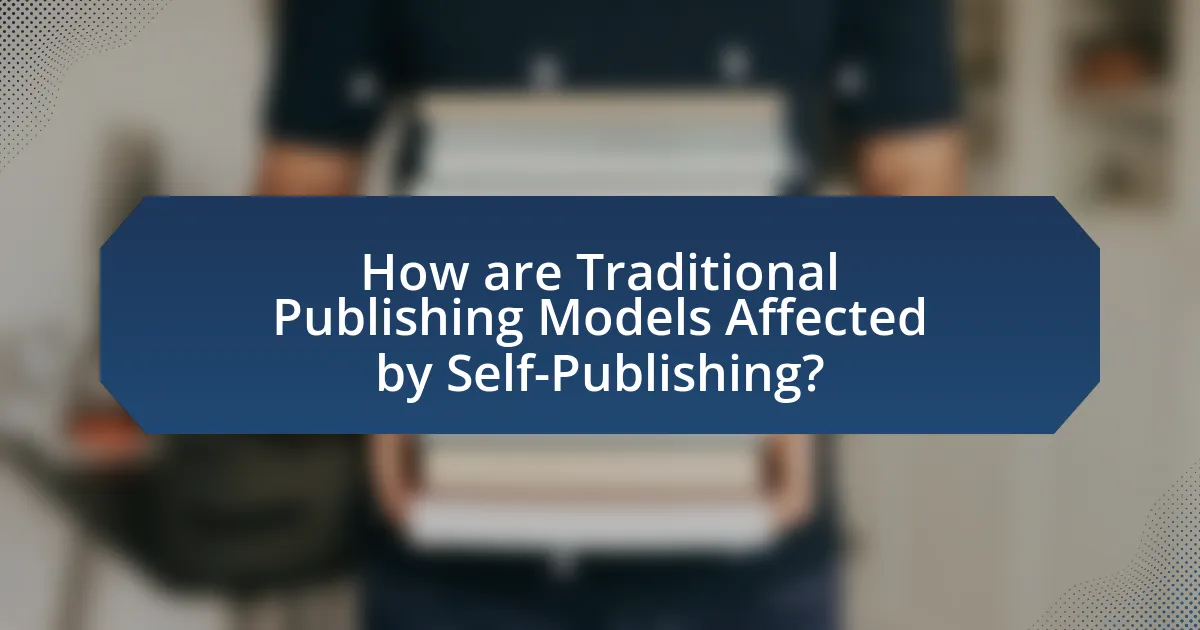
How are Traditional Publishing Models Affected by Self-Publishing?
Traditional publishing models are significantly affected by self-publishing as they face increased competition and changing consumer preferences. The rise of self-publishing platforms, such as Amazon Kindle Direct Publishing, has empowered authors to bypass traditional gatekeepers, leading to a surge in independently published works. This shift has resulted in traditional publishers adapting their strategies, including offering more flexible contracts and embracing digital formats to remain relevant. According to a 2021 report by the Association of American Publishers, self-published titles accounted for over 30% of the market, illustrating the substantial impact on traditional publishing dynamics.
What changes have self-publishing platforms brought to traditional publishing?
Self-publishing platforms have significantly democratized the publishing process, allowing authors to bypass traditional gatekeepers such as literary agents and publishers. This shift has led to increased competition for traditional publishers, as self-published authors can reach audiences directly through platforms like Amazon Kindle Direct Publishing and Smashwords. According to a 2021 report by the Author Earnings project, self-published titles accounted for over 30% of eBook sales in the U.S., illustrating the growing market share of self-publishing. Additionally, traditional publishers have adapted by incorporating hybrid models, offering services to self-published authors and recognizing the potential of digital distribution channels. This evolution has prompted traditional publishers to rethink their marketing strategies and author relationships, ultimately reshaping the landscape of the publishing industry.
How has the author-publisher relationship evolved?
The author-publisher relationship has evolved significantly due to the rise of self-publishing platforms, which have empowered authors to bypass traditional publishing routes. This shift has led to a more collaborative dynamic, where authors now have greater control over their work, including pricing, marketing, and distribution. For instance, platforms like Amazon Kindle Direct Publishing and IngramSpark have enabled authors to publish their books independently, resulting in a decrease in reliance on traditional publishers. According to a 2021 report by the Independent Book Publishers Association, self-published titles accounted for over 30% of the total book market, illustrating the substantial impact of self-publishing on the traditional publishing model. This evolution has prompted traditional publishers to adapt their strategies, often seeking to partner with successful self-published authors to leverage their established audiences.
What impact has self-publishing had on the publishing industry’s revenue streams?
Self-publishing has significantly disrupted the publishing industry’s revenue streams by allowing authors to bypass traditional publishing routes, leading to increased competition and a shift in revenue distribution. In 2020, self-published books accounted for approximately 30% of all e-book sales in the United States, illustrating a substantial market presence that diverts revenue from traditional publishers. This shift has forced traditional publishers to adapt their business models, often resulting in reduced advances for authors and a greater emphasis on marketing and distribution strategies to retain market share. The rise of self-publishing platforms has democratized access to publishing, enabling more authors to monetize their work directly, which further impacts the revenue dynamics within the industry.
Why are some traditional publishers adapting to the rise of self-publishing?
Some traditional publishers are adapting to the rise of self-publishing to remain competitive and meet changing consumer demands. The growth of self-publishing has empowered authors, allowing them to bypass traditional gatekeeping and reach audiences directly, which has led to a significant increase in the volume of published works. According to a report by Bowker, the number of self-published titles in the U.S. increased by over 400% from 2010 to 2018, indicating a shift in the publishing landscape. In response, traditional publishers are incorporating self-publishing strategies, such as offering hybrid models and services to authors, to capture a share of this expanding market and leverage the diverse content being produced.
What strategies are traditional publishers employing to compete with self-publishing?
Traditional publishers are employing several strategies to compete with self-publishing, including enhancing their marketing efforts, offering better author support, and leveraging their established distribution networks. By investing in targeted marketing campaigns, traditional publishers aim to increase visibility for their titles, which can be challenging for self-published authors. Additionally, they are providing comprehensive support services, such as editing, design, and promotional assistance, to attract authors who may prefer the resources that traditional publishing offers. Furthermore, traditional publishers utilize their extensive distribution channels to ensure that their books reach a wider audience, which is often a significant advantage over self-published works that may struggle with visibility in retail spaces. These strategies reflect the ongoing adaptation of traditional publishers in response to the growing self-publishing market.
How are hybrid publishing models emerging as a response to self-publishing?
Hybrid publishing models are emerging as a response to self-publishing by combining the benefits of traditional publishing with the autonomy of self-publishing. These models allow authors to retain more control over their work while also gaining access to professional services such as editing, design, and marketing, which are typically offered by traditional publishers. For instance, hybrid publishers often provide authors with a share of the profits, unlike traditional models that may offer only an advance and royalties. This shift is evidenced by the growth of companies like She Writes Press and Greenleaf Book Group, which cater to authors seeking a middle ground between self-publishing and traditional publishing. The rise of hybrid publishing reflects a changing landscape where authors increasingly seek greater creative control and financial benefits, responding directly to the limitations and challenges posed by traditional publishing and the self-publishing route.
What are the implications for readers and the market?
The implications for readers and the market include increased access to diverse literature and a shift in market dynamics favoring independent authors. Readers benefit from a wider range of genres and voices, as self-publishing platforms allow authors to bypass traditional gatekeepers. This democratization of publishing leads to a more competitive market, where traditional publishers may need to adapt their strategies to retain relevance. For instance, a report by the Association of American Publishers indicated that self-published titles accounted for over 30% of the e-book market in 2020, highlighting the significant impact on consumer choices and purchasing behaviors.
How does self-publishing influence reader choices and preferences?
Self-publishing significantly influences reader choices and preferences by providing greater access to diverse content and enabling niche genres to flourish. This democratization of publishing allows readers to discover works that may not fit traditional publishing criteria, leading to a broader range of voices and stories. According to a 2021 survey by the Independent Book Publishers Association, 70% of readers expressed a preference for self-published books due to their unique perspectives and innovative storytelling. This shift in reader behavior indicates that self-publishing not only expands the literary landscape but also shapes reader expectations for variety and authenticity in literature.
What trends are emerging in the market due to self-publishing?
Emerging trends in the market due to self-publishing include increased author autonomy, diversification of genres, and the rise of digital marketing strategies. Authors now have greater control over their work, allowing them to publish niche genres that traditional publishers may overlook. According to a 2021 report by the Independent Book Publishers Association, self-published titles accounted for over 30% of the U.S. book market, highlighting the growing acceptance and prevalence of self-publishing. Additionally, authors are increasingly leveraging social media and online platforms for marketing, which has transformed how books are promoted and sold. This shift indicates a significant change in the publishing landscape, where traditional models are adapting to accommodate the rise of self-publishing.

What Future Trends Can We Expect in the Publishing Industry?
The publishing industry is expected to see a significant shift towards digital-first strategies and increased reliance on self-publishing platforms. As of 2023, self-publishing has grown substantially, with reports indicating that over 1 million titles were self-published in the United States alone in 2021, reflecting a trend where authors prefer direct access to their audience without traditional gatekeepers. This trend is driven by advancements in technology, which facilitate easier distribution and marketing for independent authors, allowing them to retain a larger share of royalties compared to traditional publishing models. Additionally, the rise of artificial intelligence in content creation and personalized marketing is anticipated to further transform how books are produced and promoted, making the publishing landscape more dynamic and accessible.
How might technology further influence self-publishing and traditional publishing?
Technology will increasingly influence self-publishing and traditional publishing by enhancing accessibility, streamlining distribution, and enabling data-driven marketing strategies. Self-publishing platforms, such as Amazon Kindle Direct Publishing, allow authors to publish their work without traditional gatekeepers, leading to a surge in independent titles. According to a 2021 report by the Association of American Publishers, self-published titles accounted for over 30% of the market share in e-books, demonstrating the growing impact of technology on publishing dynamics.
In traditional publishing, advancements in artificial intelligence and machine learning facilitate better market analysis, enabling publishers to identify trends and reader preferences more accurately. For instance, tools like Bookstat provide real-time sales data and insights, allowing traditional publishers to adapt their strategies effectively. This technological integration not only enhances operational efficiency but also fosters a more competitive landscape, where both self-publishing and traditional publishing can thrive.
What role will artificial intelligence play in the future of publishing?
Artificial intelligence will significantly enhance the future of publishing by automating content creation, improving personalization, and streamlining editorial processes. AI technologies, such as natural language processing and machine learning, enable publishers to analyze reader preferences and generate tailored content, thereby increasing engagement. For instance, tools like OpenAI’s GPT-3 can produce high-quality text, assisting authors and editors in drafting and refining manuscripts. Additionally, AI-driven analytics can optimize marketing strategies by predicting trends and consumer behavior, which is crucial for adapting to the evolving landscape of self-publishing and traditional publishing models.
How could blockchain technology impact copyright and royalties in publishing?
Blockchain technology could significantly enhance copyright protection and streamline royalty distribution in publishing. By utilizing decentralized ledgers, authors can register their works on the blockchain, creating an immutable record of ownership that is easily verifiable. This transparency reduces the risk of copyright infringement and unauthorized use, as each transaction involving the work is recorded and traceable.
Moreover, smart contracts on blockchain platforms can automate royalty payments, ensuring that authors receive their earnings promptly and accurately based on predefined conditions. For instance, a smart contract could automatically distribute royalties to multiple stakeholders, such as co-authors or publishers, each time a book is sold, eliminating the need for intermediaries and reducing administrative costs. This model has the potential to increase the overall efficiency of the publishing process, as evidenced by projects like Po.et and Myco, which aim to leverage blockchain for content ownership and monetization.
What best practices should authors consider when choosing between self-publishing and traditional publishing?
Authors should consider their target audience, marketing capabilities, and financial goals when choosing between self-publishing and traditional publishing. Understanding the target audience helps authors determine which publishing route aligns with their readers’ preferences. Marketing capabilities are crucial, as self-publishing requires authors to actively promote their work, while traditional publishing often provides established marketing support. Financial goals also play a significant role; self-publishing can yield higher royalties per book sold, whereas traditional publishing typically offers an advance and lower royalties but may provide broader distribution. These factors are essential for making an informed decision that aligns with an author’s specific circumstances and aspirations.
What factors should authors evaluate when deciding on a publishing route?
Authors should evaluate factors such as control over content, financial implications, distribution reach, and marketing support when deciding on a publishing route. Control over content allows authors to maintain their creative vision, while financial implications include potential earnings and upfront costs associated with traditional versus self-publishing. Distribution reach is crucial as it determines how widely the book will be available, and marketing support can significantly impact the book’s visibility and sales. According to a 2021 survey by the Independent Book Publishers Association, 70% of self-published authors reported higher earnings compared to their traditionally published counterparts, highlighting the importance of these factors in the decision-making process.
How can authors effectively market their work regardless of the publishing model?
Authors can effectively market their work regardless of the publishing model by leveraging social media platforms, building an author website, and engaging in email marketing. Social media allows authors to reach a broad audience, with platforms like Facebook and Instagram enabling targeted advertising that can increase visibility. An author website serves as a central hub for information about the author, their books, and upcoming events, enhancing discoverability. Email marketing helps authors maintain direct communication with readers, fostering a loyal fan base through newsletters and updates. According to a survey by the Author Earnings Report, 70% of authors who actively engage with their audience on social media report higher sales, demonstrating the effectiveness of these marketing strategies.
